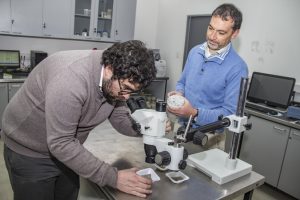Chile improves cement performance with a mixture with copper tailings
According to laboratory tests, this new material can improve performance by up to 40%
A group of researchers from the Department of Engineering and Construction Management at Universidad Católica (UC) managed to significantly improve the performance of cement materials with an innovative use of solid waste extracted from copper-mining tailings.
The research, supported by Conicyt’s National Fund for Scientific and Technological Development (Fondo Nacional de Desarrollo Científico y Tecnológico de Conicyt), CORFO’s Engineering 2030 project (proyecto Ingeniería 2030 de Corfo) and the Center for Urban and Sustainable Development (Centro de Desarrollo Urbano y Sustentable), seeks to reduce the environmental impact of the production of cement and waste from mining activity.
“The production of one metric ton of cement leads to the emission of almost one ton of carbon dioxide (CO2). This footprint is one of the main factors in the search for new materials and construction methods,” said Mauricio López, the UC engineering professor who leads the project.
 The UC engineer explained that the team of researchers analyzed the technical feasibility of creating these materials through an innovative use of copper-mining tailings by means of a new thermal and mechanical treatment of these residues, which doubles the cement capacity.
The UC engineer explained that the team of researchers analyzed the technical feasibility of creating these materials through an innovative use of copper-mining tailings by means of a new thermal and mechanical treatment of these residues, which doubles the cement capacity.
“We developed samples using tailings with and without treatment. First, we optimized the temperature and grinding time to obtain a proper microstructure and size of solid waste, replacing up to 40% of the cement with tail,” explained the engineer.
According to the expert, the use of tailings to produce cement has been previously studied. However, this waste had been tested without any treatment and had previously only allowed a 15% replacement of the cement with tail.
The tests carried out in the laboratories of Science and Technology of Construction Materials of the UC and Dictuc, where the researcher Felipe Vargas also participated, considered samples from eight tailings located in Copiapó, Salamanca and Til Til. It also included the use of iron waste, among others.
Industry
The cement used to build pavement, bridges and buildings is the third-largest contributor of environmental impact in the world, after fossil fuels and land exploitation.
Unlike the energy industry, which has managed to develop renewable sources, cement remains more or less the same as what was used more than 200 years ago. It also continues to have high demand worldwide, and demand is expected to continue to grow until the year 2050.
A scientific meeting organized by Unesco in mid-2017 called on researchers to join efforts to reduce emissions from the cement industry and to improve its performance and sustainability.




 Español
Español
